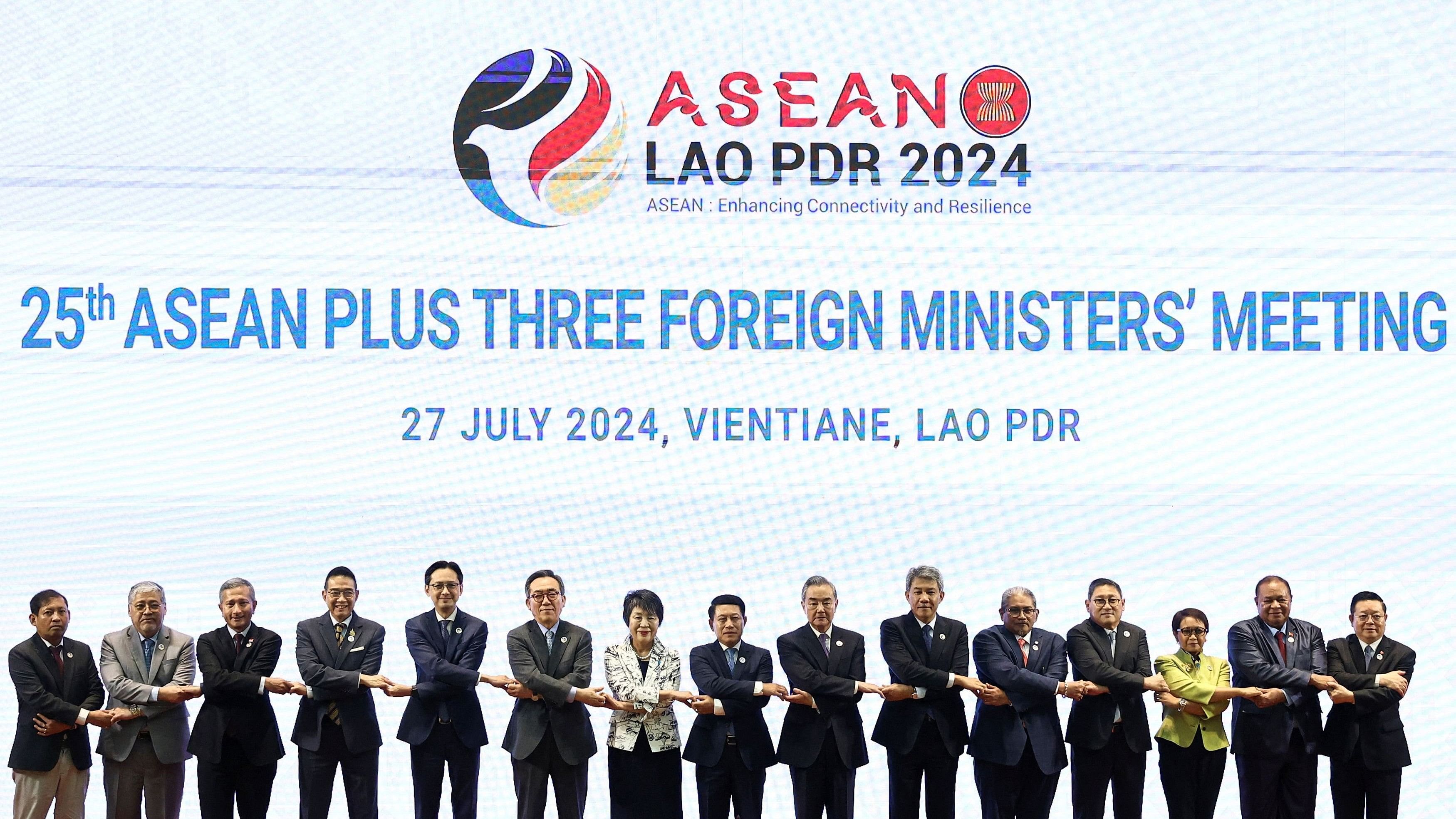
File Photo: China's Foreign Minister Wang Yi, Japan's Foreign Minister Yoko Kamikawa, South Korea's Foreign Minister Cho Tae-yul, Cambodia's Minister of Foreign Affairs and International Cooperation Sok Chenda Sophea, Laos' Foreign Minister Saleumxay Kommasith, Thailand's Foreign Minister Maris Sangiampongsa, Malaysia's Foreign Minister Mohamad Hasan, Indonesia's Foreign Minister Retno Marsudi, Philippines's Secretary of Foreign Affairs Enrique Manalo, Vietnam's Deputy Foreign Minister Do Hung Viet, Singapore's Foreign Minister Vivian Balakrishnan, East Timor's Foreign Minister Bendito dos Santos Freitas, ASEAN Secretary-General Kao Kim Hourn, and Permanent Secretary of the Ministry of Foreign Affairs of Myanmar Aung Kyaw Moe attend the 25th ASEAN Plus Three Foreign Minister Meeting in the 57th ASEAN Foreign Ministers' Meeting at the National Convention Center, in Vientiane, Laos, July 27, 2024.
Credit: REUTERS/Chalinee Thirasupa
Southeast Asian leaders will meet in Laos this week as Myanmar's civil war and mounting tensions in the South China Sea risk corroding the ASEAN grouping's central role in the region.
The 10-member Association of Southeast Asian Nations (ASEAN) has, since it was founded in 1967, created complex political structures and processes that have largely enabled peaceful cooperation within the region of over 685 million people.
But its inability to address difficult issues in a timely way may reflect a deeper differences emerging within the regional grouping, said former Indonesian Foreign Minister Marty Natalegawa.
"Both the South China Sea issue, as well as Myanmar, constitute litmus tests for ASEAN's relevance," Natalegawa told Reuters.
"My main concern...is that the sense of ASEAN cohesion and sense of common purpose has been fraying somewhat in recent years."
Known as the "Five Point Consensus", the ASEAN-led peace effort for Myanmar has made scant progress since its unveiling in April 2021, just months after the country's military staged a coup and unseated the elected government.
Instead, violence has spiraled, with the emergence of an armed resistance movement that has loosely allied with several ethnic minority rebel groups to hammer the military on multiple fronts.
Under ASEAN chair Laos, the bloc's approach has somewhat shifted from previous chair Indonesia's largely unsuccessful approach by enlarging the peace process to include Myanmar's other neighbours such as China and India, said Dulyapak Preecharush, a Southeast Asian studies scholar at Thailand's Thammasat University.
"It creates more space and less pressure for the Myanmar military," said Dulyapak.
Still, the Myanmar junta has refused to engage in talks with rivals, calling them terrorists bent on destroying the country, while ASEAN continues to bar the generals from its summits over their failure to comply with the peace plan they had initially agreed to.
On Monday, Thailand's Prime Minister Paetongtarn Shinawatra said she would work with Malaysia to use diplomatic means to resolve the conflict, underscoring what may be a renewed effort by the bloc.
Code of Conduct
The meeting in Laos will be followed by two days of summits with leaders and top diplomats from other countries, including the United States, Japan, South Korea, China and Russia.
Of concern to many of them are escalating tensions in the South China Sea between China and the Philippines, and more recently, Vietnam.
That has renewed attention on ASEAN's protracted negotiations with Beijing towards creating a code of conduct for the vital waterway, a process in motion since 2017.
China claims almost the entire South China Sea as its territory and has deployed an armada of coast guard deep into the exclusive economic zones of ASEAN members the Philippines, Vietnam, Indonesia, Malaysia and Brunei.
While some ASEAN countries are hopeful the code can be concluded in a few years, prospects for a legally binding text remain distant, according to many analysts and diplomats.
"Negotiations on the code of conduct continue at a snail's pace," former Thai Foreign Minister Kantathi Suphamongkhon told Reuters.
"Some parties to the negotiation are now hinting that the code of conduct should also not be legally binding," he said adding, "this would be unfortunate."
Ties between U.S. defence treaty ally the Philippines and China have been strained by confrontations between vessels near disputed features, triggering regional concerns of an escalation.
Last week, Vietnam also protested what it called a Chinese attack on its fishermen near disputed, Chinese-occupied islands.
China maintains its responses have been appropriate.